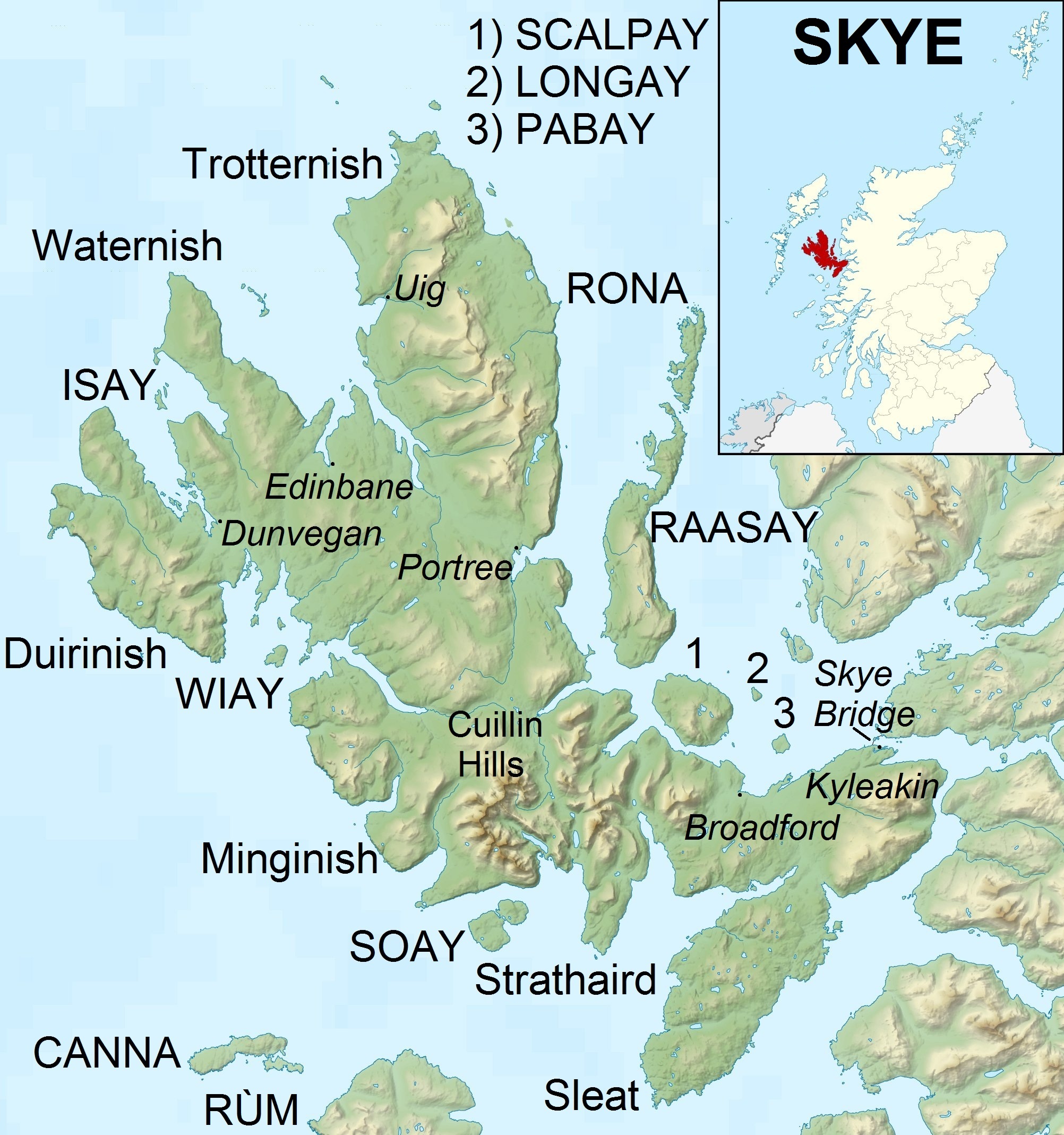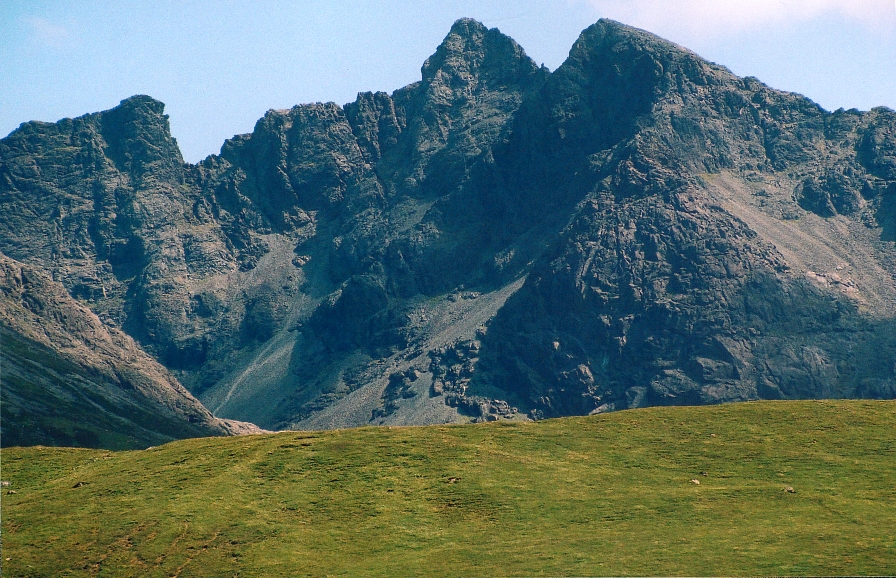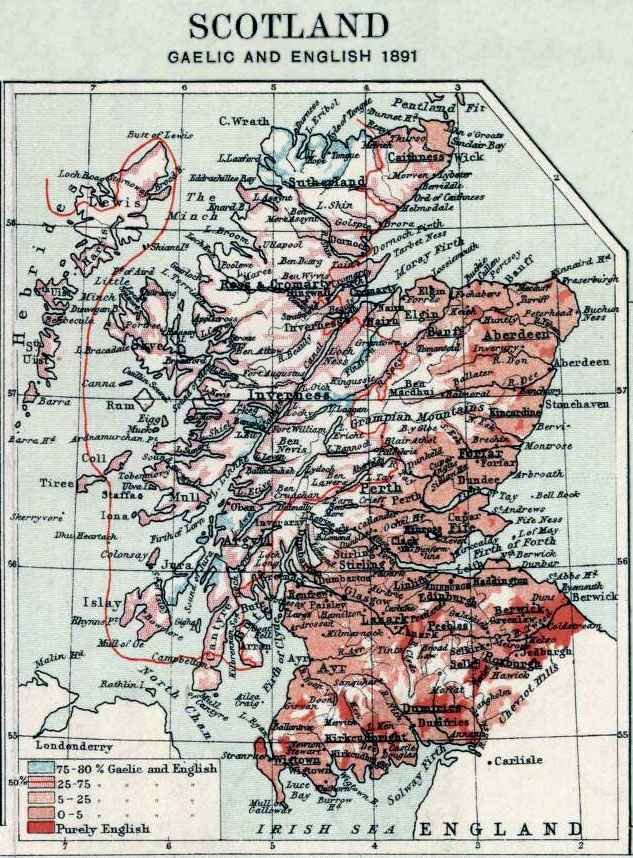|
Sgùrr Na Banachdaich
Sgùrr na Banachdaich (Gaelic for "smallpox peak"), also spelt Sgurr na Banachdich in English, is a peak in the Cuillin mountains on the Isle of Skye, Scotland. It reaches a height of , making it a Munro A Munro (; ) is defined as a mountain in Scotland with a height over , and which is on the Scottish Mountaineering Club (SMC) official list of Munros; there is no explicit topographical prominence requirement. The best known Munro is Ben Nevi ...; standing at the western edge of the Cuillin ridge, it is the most westerly of the Munros. The ascent from Glen Brittle via Coire nan Eich is one of the easiest routes to a major summit in the Cuillin, as the use of hands is not strictly required if following the main route, though it is a rough and sometimes steep walk and routefinding can be difficult if descending this route in poor visibility. All other approaches require scrambling; the other main route from Glen Brittle is via the spur of Sgùrr nan Gobhar, which involves a ... [...More Info...] [...Related Items...] OR: [Wikipedia] [Google] [Baidu] |
Munro
A Munro (; ) is defined as a mountain in Scotland with a height over , and which is on the Scottish Mountaineering Club (SMC) official list of Munros; there is no explicit topographical prominence requirement. The best known Munro is Ben Nevis (Beinn Nibheis), the highest mountain in the British Isles at 4,411 ft (1,345 m). Munros are named after Sir Hugh Munro, 4th Baronet (1856–1919), who produced the first list of such hills, known as ''Munro's Tables'', in 1891. Also included were what Munro considered lesser peaks, now known as Munro Tops, which are also over 3,000 feet but are lower than the nearby primary mountain. The publication of the original list is usually considered to be the Epoch (reference date), epoch event of modern peak bagging. The list has been the subject of subsequent variation and , the Scottish Mountaineering Club has listed 282 Munros and 226 Munro Tops. "Munro bagging" is the activity of climbing all the listed Munros. , 7,654 people had rep ... [...More Info...] [...Related Items...] OR: [Wikipedia] [Google] [Baidu] |
Scottish Gaelic Language
Scottish Gaelic (, ; Endonym and exonym, endonym: ), also known as Scots Gaelic or simply Gaelic, is a Celtic language native to the Gaels of Scotland. As a member of the Goidelic language, Goidelic branch of Celtic, Scottish Gaelic, alongside both Irish language, Irish and Manx language, Manx, developed out of Old Irish. It became a distinct spoken language sometime in the 13th century in the Middle Irish period, although a Classical Gaelic, common literary language was shared by the Gaels of both Ireland and Scotland until well into the 17th century. Most of modern Scotland was once Gaelic-speaking, as evidenced especially by Gaelic-language place names. In the 2011 United Kingdom census#2011 Census for Scotland, 2011 census of Scotland, 57,375 people (1.1% of the Scottish population, three years and older) reported being able to speak Gaelic, 1,275 fewer than in 2001. The highest percentages of Gaelic speakers were in the Outer Hebrides. Nevertheless, there is a language ... [...More Info...] [...Related Items...] OR: [Wikipedia] [Google] [Baidu] |
Isle Of Skye
The Isle of Skye, or simply Skye, is the largest and northernmost of the major islands in the Inner Hebrides of Scotland. The island's peninsulas radiate from a mountainous hub dominated by the Cuillin, the rocky slopes of which provide some of the most dramatic mountain scenery in the country.#Slesser70, Slesser (1981) p. 19. Although has been suggested to describe a winged shape, no definitive agreement exists as to the name's origin."Gaelic Culture" . VisitScotland. Retrieved 5 January 2013. The island has been occupied since the Mesolithic period, and over its history has been occupied at various times by Celtic tribes including the Picts and the Gaels, Scandinavian Vikings, and most notably the powerful integrated Norse-Gaels clans of Clan MacLeod, MacLeod and Clan Donald, MacDonald. The island was considered to be under ... [...More Info...] [...Related Items...] OR: [Wikipedia] [Google] [Baidu] |
Scotland
Scotland is a Countries of the United Kingdom, country that is part of the United Kingdom. It contains nearly one-third of the United Kingdom's land area, consisting of the northern part of the island of Great Britain and more than 790 adjacent Islands of Scotland, islands, principally in the archipelagos of the Hebrides and the Northern Isles. To the south-east, Scotland has its Anglo-Scottish border, only land border, which is long and shared with England; the country is surrounded by the Atlantic Ocean to the north and west, the North Sea to the north-east and east, and the Irish Sea to the south. The population in 2022 was 5,439,842. Edinburgh is the capital and Glasgow is the most populous of the cities of Scotland. The Kingdom of Scotland emerged as an independent sovereign state in the 9th century. In 1603, James VI succeeded to the thrones of Kingdom of England, England and Kingdom of Ireland, Ireland, forming a personal union of the Union of the Crowns, three kingdo ... [...More Info...] [...Related Items...] OR: [Wikipedia] [Google] [Baidu] |
Cuillin
The Cuillin () is a range of mostly jagged rocky mountains on the Isle of Skye in Scotland. The main Cuillin ridge is also called the Black Cuillin to distinguish it from the Red Cuillin ('), which lie to the east of Glen Sligachan.R. Anderson & Tom Prentice. ''The Grahams & The Donalds - Scottish Mountaineering Club Hillwalkers' Guide'', pp. 304–309. Published 2015. The peaks of the Black Cuillin are mainly composed of gabbro, a very rough igneous rock which provides a superb grip for mountaineering, mountaineers; and basalt, which can be very slippery when wet.D. Bennet & R. Anderson. ''The Munros: Scottish Mountaineering Club Hillwalkers Guide'', pp. 258–275. Published 2016. The rocks forming the ridge of the Black Cuillin (and outliers such Blà Bheinn) are dark, particularly in the shade, but when in sunlight the Black Cuillin can appear grey to brown. The main ridge forms a narrow crest, with steep cliffs and scree slopes. The ridge is about long (from Gars-bheinn in t ... [...More Info...] [...Related Items...] OR: [Wikipedia] [Google] [Baidu] |
Ordnance Survey
The Ordnance Survey (OS) is the national mapping agency for Great Britain. The agency's name indicates its original military purpose (see Artillery, ordnance and surveying), which was to map Scotland in the wake of the Jacobite rising of 1745. There was also a more general and nationwide need in light of the potential threat of invasion during the Napoleonic Wars. Since 1 April 2015, the Ordnance Survey has operated as Ordnance Survey Ltd, a state-owned enterprise, government-owned company, 100% in public ownership. The Ordnance Survey Board remains accountable to the Secretary of State for Science, Innovation and Technology. It was also a member of the Public Data Group. Paper maps represent only 5% of the company's annual revenue. It produces digital map data, online route planning and sharing services and mobile apps, plus many other location-based products for business, government and consumers. Ordnance Survey mapping is usually classified as either "Scale (map), lar ... [...More Info...] [...Related Items...] OR: [Wikipedia] [Google] [Baidu] |
Alexander Nicolson
Alexander Nicolson (Scottish Gaelic: Alasdair MacNeacail) (1827–1893) was a Scottish lawyer and man of letters, known as a Gaelic scholar and sheriff-substitute of Kirkcudbright and Greenock, and as a pioneer of mountain climbing in Scotland. Life The son of Malcolm Nicolson, he was born at Husabost in Skye on 27 September 1827. With an early education from tutors, he entered Edinburgh University after the death of his father, intending to study for the ministry of the Free Church of Scotland. He graduated B.A. in 1850, and later in 1859 received an honorary degree of M.A. In the absence through illness of Sir William Hamilton, Nicolson as his assistant lectured for his class on logic, and for two years he performed a similar service for Patrick Campbell Macdougall in the class of moral philosophy. Giving up theology while at the Free Church College, Nicholson for some time worked as one of the sub-editors of the eighth edition of the Encyclopædia Britannica. He moved on, t ... [...More Info...] [...Related Items...] OR: [Wikipedia] [Google] [Baidu] |
Scottish Gaelic
Scottish Gaelic (, ; Endonym and exonym, endonym: ), also known as Scots Gaelic or simply Gaelic, is a Celtic language native to the Gaels of Scotland. As a member of the Goidelic language, Goidelic branch of Celtic, Scottish Gaelic, alongside both Irish language, Irish and Manx language, Manx, developed out of Old Irish. It became a distinct spoken language sometime in the 13th century in the Middle Irish period, although a Classical Gaelic, common literary language was shared by the Gaels of both Ireland and Scotland until well into the 17th century. Most of modern Scotland was once Gaelic-speaking, as evidenced especially by Gaelic-language place names. In the 2011 United Kingdom census#2011 Census for Scotland, 2011 census of Scotland, 57,375 people (1.1% of the Scottish population, three years and older) reported being able to speak Gaelic, 1,275 fewer than in 2001. The highest percentages of Gaelic speakers were in the Outer Hebrides. Nevertheless, there is a language ... [...More Info...] [...Related Items...] OR: [Wikipedia] [Google] [Baidu] |
Smallpox
Smallpox was an infectious disease caused by Variola virus (often called Smallpox virus), which belongs to the genus '' Orthopoxvirus''. The last naturally occurring case was diagnosed in October 1977, and the World Health Organization (WHO) certified the global eradication of the disease in 1980, making smallpox the only human disease to have been eradicated to date. The initial symptoms of the disease included fever and vomiting. This was followed by formation of ulcers in the mouth and a skin rash. Over a number of days, the skin rash turned into the characteristic fluid-filled blisters with a dent in the center. The bumps then scabbed over and fell off, leaving scars. The disease was transmitted from one person to another primarily through prolonged face-to-face contact with an infected person or rarely via contaminated objects. Prevention was achieved mainly through the smallpox vaccine. Once the disease had developed, certain antiviral medications could poten ... [...More Info...] [...Related Items...] OR: [Wikipedia] [Google] [Baidu] |
Ainmean-Àite Na H-Alba
Ainmean-Àite na h-Alba (; "Gaelic Place-Names of Scotland") is the national advisory partnership for Gaelic place names in Scotland. Ainmean-Àite na h-Alba are based at Sabhal Mòr Ostaig on Skye. History Ainmean-Àite na h-Alba began as the Gaelic Names Liaison Committee, established in 2000 by the Ordnance Survey to improve consistency in Gaelic names on their mapping products. The committee expanded to become the Ainmean-Àite na h-Alba partnership in 2006. Functions Ainmean-Àite na h-Alba research and agree on place names, using local knowledge, historical sources and the principles of the Gaelic Orthographic Conventions. These names are used by local councils, roads authorities and the Ordnance Survey for signs and maps. AÀA are also producing a National Place-Names Database. This database was launched in August 2010, and contains over 3000 entries. Partnerships The partners are Argyll and Bute Council, Bòrd na Gàidhlig, Comhairle nan Eilean Siar, Highlands and I ... [...More Info...] [...Related Items...] OR: [Wikipedia] [Google] [Baidu] |
Glen Brittle
Glen Brittle (''Gleann Breadail'' in Scottish Gaelic) is a large glen in the south of the Isle of Skye, in Scotland. It runs roughly south to north, along the River Brittle, which has its mouth at Loch Brittle (a sea loch). The glen is bounded on the east by the main Black Cuillin ridge, the largest mountains on Skye. The name is probably derived from old Norse ''Bred Dal'' ("broad valley") with the Gaelic ''glean'' ("valley") being prefixed later. Many tributaries of the Brittle run down from these mountains into the glen, including a stream with waterfalls known as the much-visited Fairy Pools. Because of its location by the peaks, the area is popular with hikers and mountain bikers. A single road runs through the glen on the east side of the river. On the slopes on the west side there are large sections of forest maintained by Forestry and Land Scotland. There are two hamlets in the south of the glen - Glenbrittle and Bualintur. Near the mouth of the River Brittle is the Gl ... [...More Info...] [...Related Items...] OR: [Wikipedia] [Google] [Baidu] |







